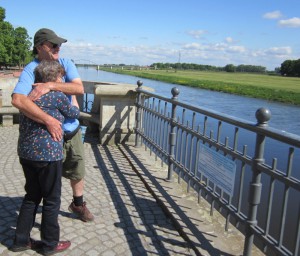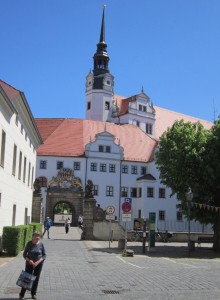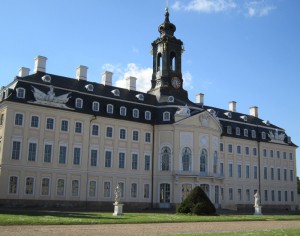Friday 15 May – in which we take in a lot of history
Today we visited Torgau, another picturesque town along the Elbe, but with some interesting history. Torgau is well known as the place where the US and Soviet forces met during the Second World War, on 25 April 1945, later known as Elbe Day. This is the first fact mentioned by our hosts at the hotel when we said we were going to Torgau.
The memorial to the meeting is also the first sight we saw after we had parked. It is a plaque alongside the river overlooking a long bridge. The original bridge was destroyed in the war.
We then went into the Torgau castle, which is unique in that it still has brown bears in the moat. Only one was visible when we went by. There was an exhibition called “Luther und die Fursten” in the castle, which we went through with audio guides. It was all about protestant reformation and all the political intrigues and battles related to it in Saxony. There were some very old objects – old original bibles and other texts from 16th century, old suits of armour and robes, pictures and so on. Also a sash that one of the kings wore in battle, was then injured and used as a field dressing – he later died. It still had his blood on it and there were fragments of the musket balls that had killed him. Another object that I remember was a chalice that had been made bigger, by adding an extra lip around the edge – this was after they came to a compromise to allow the members of the congregation to take communion.
Torgau is very significant because the Protestant dukes signed a treaty of mutual assistance here. It was also here where Luther and his friends worked out the articles that later became the basis of the Augsburg Confession – this is why the town is sometimes called the “wet nurse” of reformation. We visited the superintendents house where these articles were written.
I was also impressed with the castle church, which was the first Protestant church built in Germany in accordance with Luther s ideas He consecrated it himself in 1544. They had a recording of his sermon and the hymn composed for the occasion by Johann Walter playing in the church. The alter is according to Luther statements – “a simple free-standing table resembling early Christian traditions”. The most decoration is around the pulpit, which has stories relevant to the reformation – Jesus interpreting scripture in the temple as a child, Jesus and the adulteress (forgiveness by grace alone) and Jesus driving the money changes out of the temple.
The town church of St Mary is also nearby the castle and of special significance as Luther’s wife, Katharina von Bora is buried there – there is a memorial to her in the church and it was touching that someone had left fresh flowers there.
There were also a number of exhibition halls off the castle outlining peoples experiences of the Second World War – all in German but interesting to Elsbeth.
We had lunch sitting outside at an Italian restaurant (served by a Greek waiter!). The town was very quiet, just a few tourists around.
We then walked on to the town square, where there was a fun fountain featuring a bear, a dog and some jesters. Also an ice cream parlour, where we bought some yummy cones.
On our way back we went through Wermsdorf as our map indicated there was something of historical significance there – we found it – the biggest castle in Saxony. This is called Hubertusburg Castle and was built as a “temporary” residence for Augustus I. We pretty much had the place to ourselves – it is massive and some of the buildings seem to be empty and in the process of being restored. It doesn’t seem like it is really being promoted as a tourist destination, unlike other castles such as Moritzburg. One wing of the castle houses a state archives and there is a hospital at the rear of the grounds. We found out from plaques on the wall that this is the site where a treaty was signed in 1763 that ended the Seven Years war, together with the Treaty of Paris.
Our last town of the day on the way back was Oschatz – we only stopped briefly. Another cute town with a typical town square – it was nice that the church bells were ringing when we arrived.


